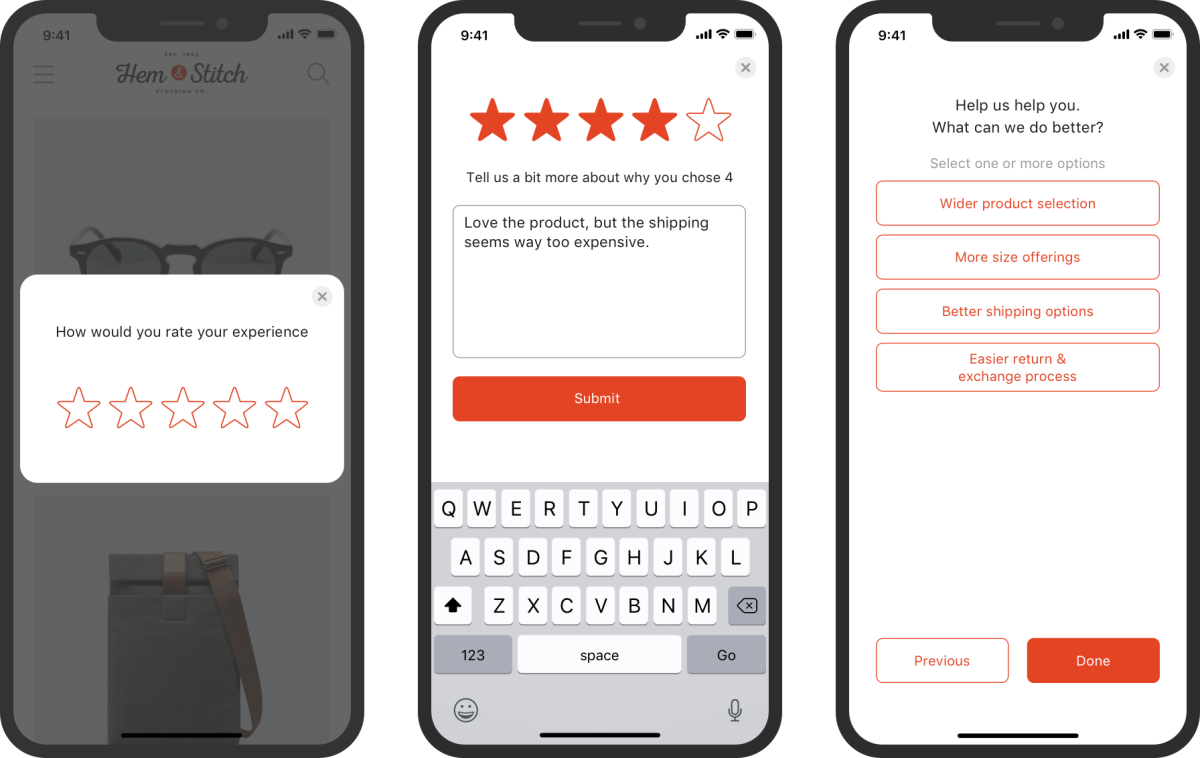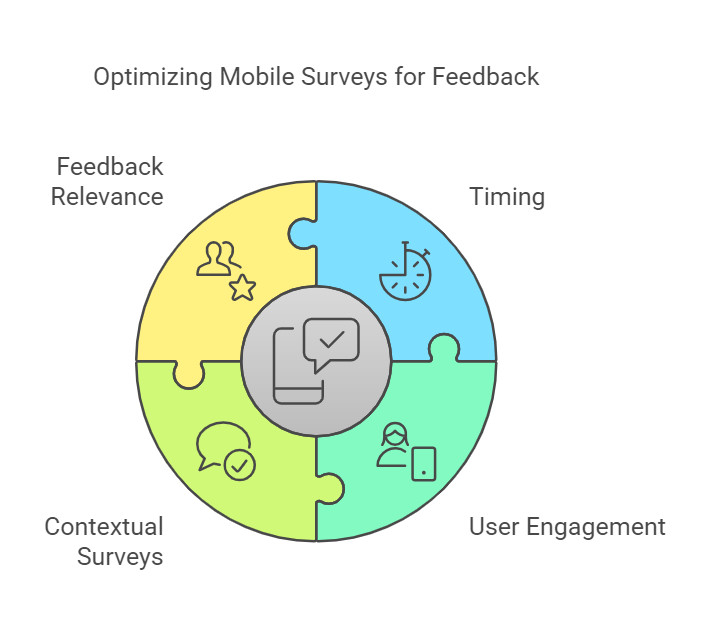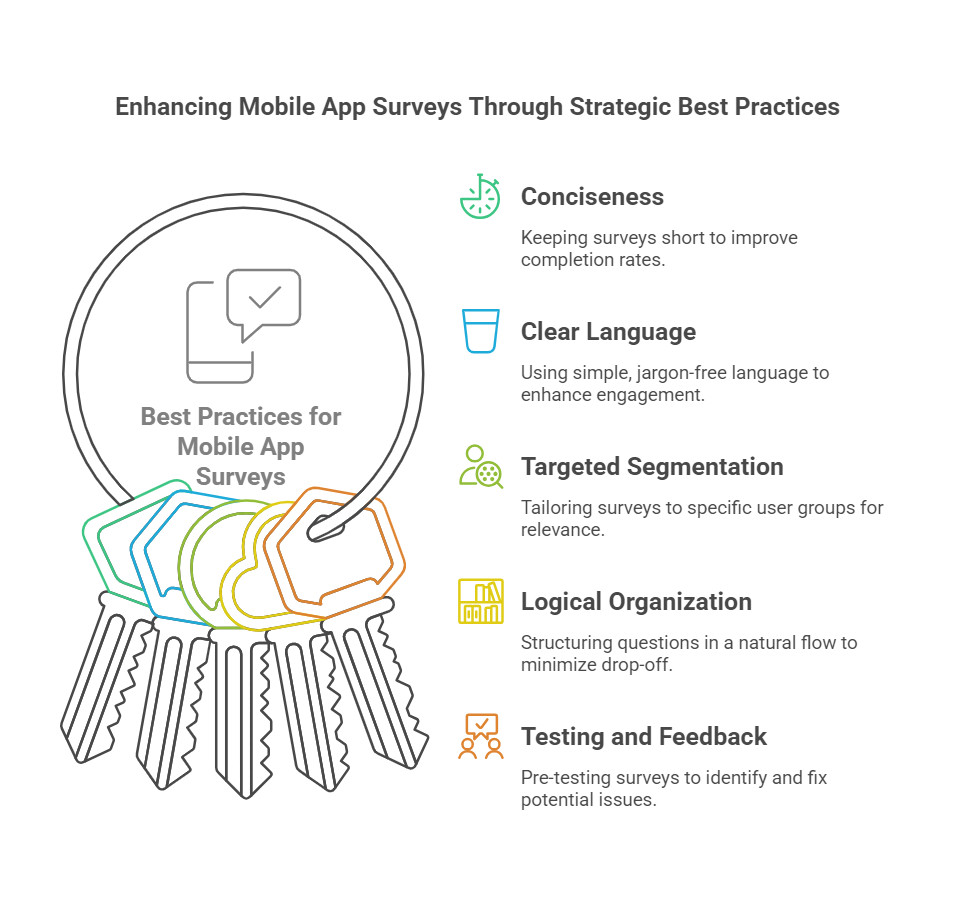- Research platform
Sources of information
Data analysis
Actions
- Solutions
For whom
Problems / Issues
- Materials
Materials
- About us
About us

When are mobile surveys best? This question matters for business that want to improve customer engagement and gain feedback. Mobile surveys, combined with an app feedback tool, bring brands closer to customers. They collect real-time insights and help drive improvement. In this article, we’ll look at the strategic benefits of mobile surveys. Discover the types and best practices. Knowing when to use these surveys increase honest feedback. It helps build better customer relations. Whether it’s for product devlopment or improving user experience, insights from mobile surveys move business ahead. Let’s explore the main benefits and talk about using in-app surveys to increase performance. Mobile surveys turn customer interactions into lasting connections.
Mobile surveys work best at specific time. Quick surveys after tasks can capture better insights. Customers respond well when they’re engaged in an app. Frequent surveys can annoy users, so choose wisely. Survey design matters too, short questions encourage participation. Respondents are likely appreciated good user experiences. Analyzing responses prompt action and strength business.
To sum it up, using mobile surveys strategically leads to fruitful feedback loops. Timing and understanding user habits is crucial for creating them. Companies focusing on customer satisfaction should integrate mobile surveys tirelessly.
In-app feedback refers to the process of collecting user feedback and opinions directly within a mobile app or web application. This type of feedback is crucial for understanding user behavior, identifying pain points, and improving the overall user experience. In-app feedback can be collected through various methods, including in-app surveys, feedback widgets, and app performance management software. By integrating these tools, businesses can gather real-time insights from users as they interact with the app, making it easier to address issues promptly and enhance the overall functionality. This direct line of communication with users ensures that feedback is relevant and actionable, providing a solid foundation for continuous improvement.
Collecting in-app feedback is essential for businesses that want to create a user-centric product. By gathering feedback directly from users, companies can gain valuable insights into their needs, preferences, and pain points. This information can be used to inform product development, improve customer satisfaction, and increase user engagement. In-app feedback also helps businesses to identify and fix issues quickly, reducing the risk of negative reviews and improving overall app performance. By actively listening to users and making data-driven decisions, companies can foster a loyal user base and stay ahead in a competitive market. The insights gained from in-app feedback are invaluable for creating a product that truly resonates with its audience.
Mobile surveys work well right after user interactions. This setup allows for effective feedback capture. For example, asking for feedback after a purchase or a major feature use brings up the engagement. This makes user responses more relevant to what they experience at that time.
Survey timing is vital for effective results, and an app survey can collect insights while they’re still fresh in the user’s mind. Studies prove that immediate requests collect insights while it’s still fresh in user’s minds. Delayed or interruptive surveys can frustrate users, decreasing response rates. It’s key to choose right moment for asking feedback. Balance timeliness with user engagement is essential.
Additionally, using contextual surveys—designed for specific points in a user journey—raises the chance of meaningful feedback. For instance, asking users for thoughts right after completing a task or using a feature maximizes response rates. This connects feedback to their recent actions and experience moments. As a strategy, focus on reaching out soon after important tasks, capturing changes in sentiment efficiently.
To sum up, mobile surveys are better when timed carefully. Avoiding disruptions helps ensure user responses are relevant. Grasping timing dynamics enables closer alignment with user experiences. This leads to enhanced data collection and valuable customer insights.
With that basis set, we can explore benefits of mobile surveys and their role in boosting customer engagement.

Mobile surveys are great for businesses that want to engage customers and collect insights. They have higher response rates compared to standard surveys. People are more likely to answer surveys in the apps they’re already using. Evidence shows mobile surveys can reach response rates over 30%.
Another benefit of mobile surveys is obtaining mobile app feedback that is relevant. When users share their thoughts while using an app, it provides valuable context for businesses. Customers’ opinions gained in real time helps identify key problems and areas to enhance, leading to useful insights that can be acted on quickly.
Besides, mobile surveys allow for instant data collection important for decision making. Businesses benefit from analyzing data as it comes through. This allows them to respond fast to what users want and adapt to the market changes. In today’s quick-moving digital world, this flexibility is necessary as conditions change fast.
In conclusion, when are mobile surveys best? They increase engagement by giving easy access to users. Additionally, they improve feedback quality and support effective business strategies. This helps in keeping customers satisfied and returning for more.
Customer feedback plays a crucial role in monitoring app performance. By collecting feedback directly from users, businesses can identify issues with the app’s functionality, usability, and overall performance. This information can be used to prioritize bug fixes, optimize app performance, and improve the user experience. In-app feedback also helps businesses to track user behavior and identify trends, enabling them to make data-driven decisions to improve the app’s performance. Regularly gathering and analyzing feedback ensures that the app remains responsive to user needs and expectations, leading to higher user satisfaction and retention rates. This proactive approach to performance monitoring helps maintain a high-quality app that users can rely on.
Customer feedback is a critical component of product roadmap planning. By collecting feedback directly from users, businesses can identify areas for improvement, prioritize feature development, and inform product decisions. In-app feedback helps businesses to understand user needs, preferences, and pain points, enabling them to create a product roadmap that meets user expectations. This approach ensures that the product is developed with the user in mind, increasing the likelihood of success and adoption. By incorporating user feedback into the planning process, companies can make strategic decisions that align with market demands and enhance the overall user experience. This user-centric approach to product development fosters innovation and drives long-term success.
Mobile surveys enable different methods for collecting feedback. One key format is in-app surveys. These are within the app itself. This makes it easy to gather real-time feedback while users engage with the app. After completing a task, in-app surveys ask for users’ thoughts. This keeps insights fresh and relevant.
Another common type of mobile survey includes Net Promoter Score (NPS) and Customer Satisfaction (CSAT) surveys. This surveys gauge user satisfaction and loyalty. Typically, NPS surveys ask users how likely they are to recommend the app. CSAT surveys check satisfaction with specific features. Studies show about 80% of customers prefer when businesses ask for feedback, especially about product experiences.
Behavioral feedback is also collected through interactive widgets, such as an in app feedback widget, in the app. These widgets create ongoing insights based on user behavior and preferences. This helps create a constant data flow. A responsive feedback system lets companies adapt strategies in real-time. User-centered improvements become possible with this method.
In conclusion, using various feedback collection types lets businesses gather comprehensive insights. This enhances customer satisfaction and improves service offers.

Collecting valuable feedback through mobile app surveys requires following best practices to ensure a positive experience for app users. Well-designed surveys enhance user experience and boost completion rates. Here are some practices to consider when are mobile surveys best.
Implementing theses practices creates effective mobile surveys, gathering useful feedback and connecting deeply with customers. Understanding mobile user behavior forms a basis for insightful analysis.
Next, let’s explore how to effectively utilize in-app surveys to maximize customer engaging potential.
When are mobile surveys best? Their placement matters in the app to effectively collect customer feedback without interfering with user activity. Position them for moments that boost engagement without interfering with user activity. For instance, asking after a successful transaction or a completed task can produce thoughtful feedback. Timing is key to keeping users engaged.
Also, checking and analyzing responses from in-app surveys is essential for taking actions. Using analytics tools can help spot trends and user feedback patterns. Focusing on performance indicators aligning with customer experience goals is crucial. This focuses attention on areas for improvement.
Finally, applying insights from in-app surveys into product and service strategies improves user satisfaction and loyalty. Building a feedback loop allows users to see changes from their suggestions. Communicating updates to users shows how their feedback shapes app improvements, strengthening community ties and future participation.
Grasping how to use in-app surveys effectively is vital for connecting with users and enhancing the overall experience. Moving from best practices to using strong tools can improve data collection accuracy and depth.
YourCX works well with mobile survey platforms, providing app feedback tools that boost data collection and get better insights into customers. When companies add YourCX for mobile surveys, they receive feedback from users during interactions. This helps in making the user experience better. Real-time data collection is another benefit. Organizations act fast on the feedback received from customers. More efficient responses improve business operations and customer relations.
The platform gives strong analytics needed to grasp customer needs and improve engagement in mobile channels. With thorough analytics of customer experiences, businesses locate trends and problems. Analysis of feedback from mobile surveys allows firms to enhance product features and user design. A focus on data benefits customer loyalty.
YourCX helps businesses manage feedback for continuous enhancement. This platform allows analyzing feedback without delay. Companies make smart decisions quickly which matters in a fast market. Immediate responses to feedback show customers dedication to satisfaction. This leads to a stronger bond between the brand and clients, making connections deeper.
In the digital age, using mobile app surveys is a simple way to gather feedback and engage with customers. We discussed when are mobile surveys best for insights. Their benefits include real-time data capture and improved user engagement. Understanding feedback types and practices helps achieve survey goals.
Now is the ideal moment to act on these insights. Adding mobile surveys in your app can strengthen the bond with your users while collecting insights for smart decisions. Remember, mobile surveys work well when you time them right and design questions to get honest answers.
As you look to boost customer experience via mobile app surveys, consider leveraging their potential for better communication. Actively reaching out to users builds a space for ongoing improvement and success. Begin today and see how powerful feedback can elevate your connection with customers.
Copyright © 2023. YourCX. All rights reserved — Design by Proformat